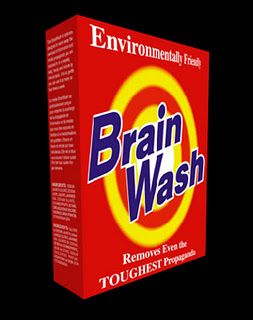Unconscious
7 Unconscious Errors We Make When Buying Brands
Our purchase decisions can be highly irrational and costly.
Posted January 13, 2014

The way we decide to buy brands is mind-blowing.
Here are seven fascinating mental mistakes we make when purchasing the products and services we use every day. Since these errors are made unconsciously, we need to first become aware of them. Recognizing the irrationality of our decisions can help us make more informed, sensible choices and save money.
1. We create value where there is none and pay more than we should.
Brands add value not in the product but rather within our minds. That’s because our enjoyment is shaped by our expectations and these are molded by our memories. The problem is, most of these brand memories are stored in our vastly more powerful unconscious mind.
When we think about buying something we automatically dredge up all of our past impressions and summarize the brand’s worth in the form of gut feelings—good, bad, or indifferent. The sum total of these feelings is what advertisers call Brand Equity. We don’t remember all the experiences just the overall impression. The more positive the feeling the more likely we are to buy and pay more for the brand.
There is little logic to how we come to love our favorite brands. Reade Montague and his team at Baylor College of Medicine demonstrated this when they recreated the famous Pepsi Challenge with a twist. Volunteers agreed to have their brains scanned while comparing the taste of Coke to Pepsi. The original Pepsi Challenge demonstrated that most people prefer the taste of Pepsi in blind taste tests, i.e., without knowing which brand they were drinking. Yet Coke is purchased more in the real world. How does one reconcile these observations?
Montague’s team found that when participants were unaware of the brands being tasted, preference levels and neurological responses were similar. But when participants were aware of the brand by exposing them to an image of the can before they tasted the beverage, they stated a greater preference for Coke and there were significantly greater activation of the areas of the brain involved in decision making, memory, associations, and emotions. Merely seeing the Coke label was enough to generate greater activation in the brain’s pleasure centers and elevate dopamine levels without even taking a sip!
Not only do brands transform our beliefs and experiences, we feel even better about a product just because it costs more. That’s because experience has taught us that things that are expensive are usually higher quality. This heuristic or “rule of thumb” makes us pay as much as 85 percent more for a brand-name drug than for the generic, even though the FDA requires generic drugs to have the exact same quality and performance.
Scientists at Caltech and Stanford demonstrated this when they told subjects they would be comparing Cabernet Sauvignons at various price points when in fact the researchers gave the participants the same wine and varied only the price. The subjects consistently believed the higher priced wine tasted better. Later, brain scans revealed that there was greater activation in a pleasure center of the brain when the participants in the study believed they were drinking more expensive wine, even though the wines were identical!
2. We make decisions by emotional association more so than rational analysis.
Perhaps the most important finding in neuroscience has been the discovery that emotions are central to cognition and decisions. Advertising works by a process of Unconscious Behaviorism. We are being conditioned by the media on a deep unconscious level and it is this implicit associative emotional conditioning that drives our brand preferences.
This was demonstrated in a study that exposed participants to made-up brands paired with a set of pictures and words, some negative and some positive. After seeing hundreds of images paired with several fictitious brands, the subjects were unable to recall which brands were associated with which pictures and words, but they still expressed a preference for the positively conditioned brands. The authors of the study labeled it the “I like it, but I don’t know why” effect. In a follow-up experiment the participants were presented with product information that contradicted their earlier impressions, offering them reasons to reject the products they had been conditioned to like, but they still chose the brands associated with the positive imagery. Factual information to the contrary did not undo the prior conditioning, suggesting that their product selections were driven more by unconscious conditioning rather than rational analysis.

This means you can be conditioned through advertising to choose logically inferior options. We can even become conditioned to find great pleasure in things that harm us. For instance, why do we love the smell of a brand new car so much? The scent symbolizes the pride of ownership that elevates our ego with a feeling of specialness and importance. But this fresh, new odor is actually a potpourri of poison and toxic gases. Even when the new scent fades over time, we voluntarily extend our daily exposure to additional chemical cocktails by purchasing fake new-car scents that contain aldehydes, esters, and ketones.
Even those scary warning labels on cigarette packs about the risks of heart disease or emphysema can stimulate the nucleus accumbens, the “craving spot” in the brains of smokers as shown in another study. Apparently the warning label had become associated with the past pleasures of smoking rather than effectively warning people of future health risks.
3. When we have strong positive emotions about a brand we seek supporting evidence and ignore contradictory facts.
We are not rational; we are rationalizers. We make our decisions based on emotions and look for supporting evidence as justification. When our emotional desires begin to shift toward a prospective brand, we subsequently seek to align our reasons to be consistent with that intention. Our rational mind is always looking for evidence to support our dominant beliefs...the stronger the emotion, the stronger the belief, and the greater the tendency to seek out supporting evidence. This confirmatory bias is why we often overlook the flaws of the ones we love, even if that loved one is a brand. We focus our attention on the positive qualities of the brand while ignoring the deficiencies. This predilection is also what prevents Republicans and Democrats from finding common ground in the same set of facts, and why it is impossible to win an argument with someone on an emotionally charged issue like abortion or the existence of God. No amount of reasoning can overcome strong feelings because the emotionally charged mind will always find its reasons to believe.
To nudge us toward their brand, marketers often invent unique factual product-based differences. The trademark ingredient Retsyn in Certs breath mints, the patented additive Techron in Chevron gas or the “Sheeting-Action” in Cascade dish detergent provide just enough logic to overcome our resistance and open our wallets.
4. We draw conclusions based upon how the information is presented—not the actual information itself.
An ad for cream cheese that states 95% fat free is more likely to convince us than one that says it contains 5% fat. The facts are identical but it is the positive spin not the concrete evidence that drives the appeal.
Rather than simply stating the facts most advertisers typically embed their message into creative contextual devices that evoke feelings and bypass rational resistance. This is why advertisers use stories, poems, slogans, songs, jokes, pictures, symbols, characters, roles, and metaphors. They are particularly ripe marketing tools, because they lead the imagination and evoke the feelings that strike at our heart not our head.
One popular technique is the use of a spokesperson. We can transfer favorable feelings about the person to the brand even if the character’s role is fictitious. For example, when actor Peter Bergman, who played Dr. Cliff Warner on the soap opera All My Children, starred in a commercial for Vicks Formula 44 and espoused, “I’m not a doctor, but I play one on TV,” many viewers took his words as a credible endorsement. Since they had often seen Bergman in a white lab coat, in their eyes he had license to become a real medical authority.
5. The more we are exposed to a brand the more we like it.

The number one drive in human behavior and biology is homeostasis, or the seeking of the same stable, balanced, predictable state. All humans (and therefore all consumers) find a great deal of comfort and pleasure in what is known and familiar.
Psychologist Robert Zajonc of Stanford University demonstrated that familiarity breeds affection, a process he labeled the “mere exposure effect.” Zajonc showed participants a randomly chosen series of shapes in rapid succession, making it impossible for the group to consciously discern how often each shape was shown. What he found was that when asked which shapes they found most pleasing, subjects would reliably choose those that they had been exposed to most often, even though they had no conscious awareness of how often they had seen the shapes or which they’d seen more often.
So it's no wonder we are exposed to thousands of ads each day. For example, Coke’s focus has always been establishing an instantly recognizable and appreciated brand. Through the classic, consistent logo, the iconic contour of the bottle’s design, the mellifluous alliteration of the brand name, its investment in world-class, heart-warming advertising, and a pervasive retail presence, it became not only the first truly global brand but also the most recognized trademark in the world. In 2011 the Coca-Cola brand was worth an estimated $74 billion—more than Budweiser, Pepsi, Starbucks, and Red Bull combined—a position maintained by spending $2.9 billion in advertising in 2010, more than Microsoft and Apple’s advertising budgets put together.
Mere exposure over time can override even our instincts for survival. Take for instance our insatiable and sometimes costly addiction to coffee. All humans actually have an innate distaste for bitterness, an omnipresent characteristic of all coffees. When tasting something bitter, a common reaction for humans would be to spit it out to avoid poisoning, since bitterness signals warning of the presence of toxins. This is why children don’t usually like the taste of coffee and why bitter-tasting synthetic chemicals are commonly added to toxic substances, like antifreeze and denatured alcohol, to avoid accidental poisoning. But thanks in part to powerful brands like Starbucks, modern humans have learned to override and transform our innate distaste for bitter flavors into a compulsory delight. We learn to associate coffee with these rituals of relaxation and socialization, as well as the pleasurable effects of caffeine and transform a cheap commodity into a five-dollar indulgence. No wonder there is a Starbucks on every corner.
6. We make decisions based upon the memories of our experiences—not the actual experiences.
According to Harvard-trained brain experts Jeff Brown and Mark Fenske, we remember better and encode more strongly when we are in a highly emotional state. Marketers are not the architects of advertising. They are the architects of remembrance. How we feel about a brand largely depends upon our memory of the experience provided by the brand, not what actually happened. These are not based on the reality of these experiences but almost entirely on the peak moments and the concluding impression—whether positive or negative—the brand has produced. This tendency is what the behavioral economist Daniel Kahneman calls the “peak-end rule.”

A textbook example of this was a project dubbed “Red Bull Stratos” with the lofty mission of transcending human limits. On October 14, 2012 Felix Baumgartner ascended to the edge of space as the world watched live on the edge of their seats. The supersonic skydiver made the death-defying, record setting plunge escaping a “death spin” to avert tragedy and touch down safely unharmed. It is no surprise that Red Bull continues to dominate the energy drink market, a category they single-handedly created.
7. We are convinced by advertising based on consistency and coherence, not the quality and quantity of information.
The best ad campaigns involve a simple clear emotionally evocative idea repeated over and over again. Less is in fact more, which helps explain the ubiquitous presence of the 30-second commercial. The conscious mind will leap to conclusions, forming a coherent narrative based upon partial information. This strong tendency to draw conclusions from incomplete information is a cognitive rule that Kahneman calls “What you see is all there is.” Kahneman argues that consistency and coherence, not quantity or quality of information, are the keys to forming opinions.
As Kahneman describes it, “Neither the quantity nor the quality of the evidence counts for much in subjective confidence. The confidence depends on the quality of the story they can tell.” So it’s not surprising that one of the hottest new forms of advertising is “Branded Content”. Increasingly advertisers are choosing to spend their investments often in the form of entertaining stories that blur the line between conventional advertising and entertainment. We might enjoy these new forms of advertising better, but we also may become more influenced by them without ever knowing why.
If you’d like to learn more about Unconscious Behaviorism check out my book Unconscious Branding or follow me on Twitter.




